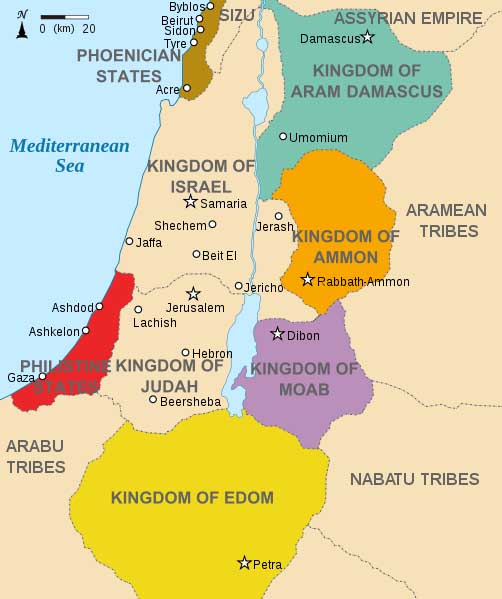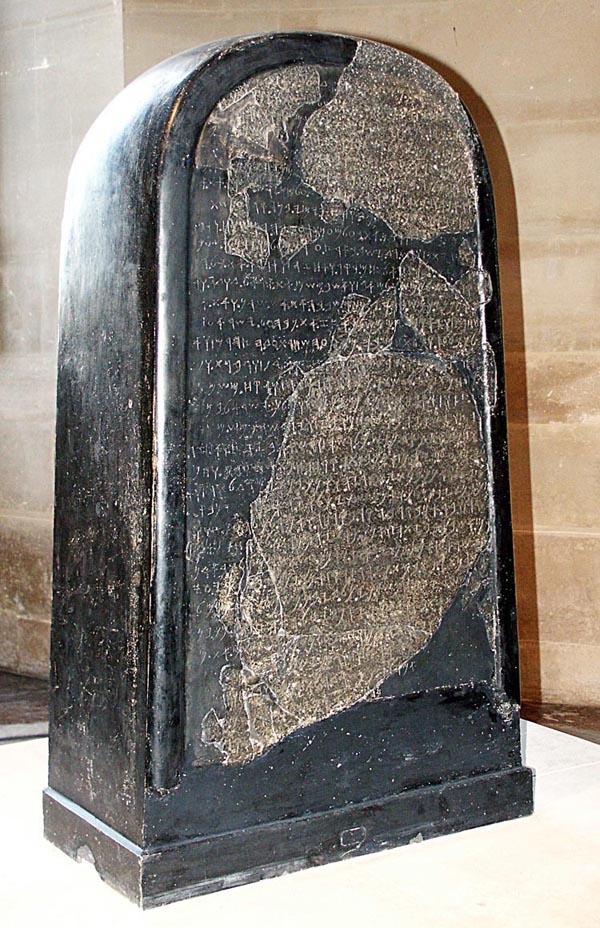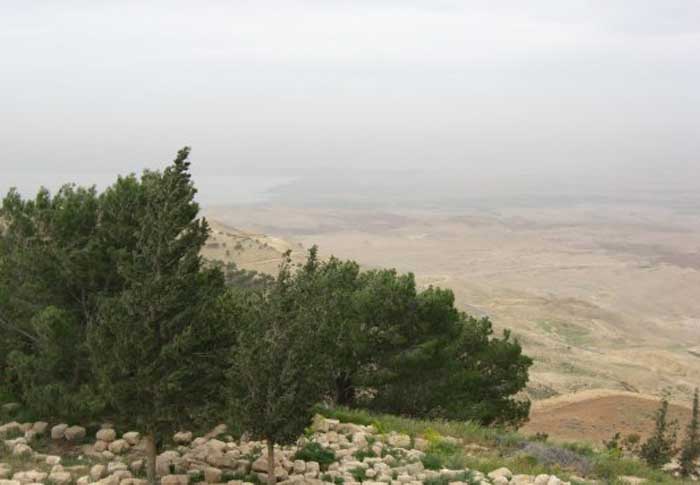



Moab is the historical name for a mountainous strip of land in modern-day Jordan running along the eastern shore of the Dead Sea. In ancient times, it was home to the kingdom of the Moabites, a people often in conflict with their Israelite neighbors to the west. The Moabites were a historical people, whose existence is attested to by numerous archeological findings, most notably the Mesha Stele, which describes the Moabite victory over an unnamed son of King Omri Israel.

The Moabite Stone, also called the Mesha Stela, is an inscribed black basalt monument written in the Moabite language in c. 835 BC. It stands nearly four feet tall and was found in 1868 in the land of ancient Moab, now modern Jordan. It contains references to Biblical figures such as Israelite King Omri and Moabite King Mesha (cf. 1 and 2 Kings), as well as the covenant name of God, YHWH (cf. Exodus 3). It is now located in the Louvre.

Moab and the Dead Sea
Moab occupied a plateau about 3,000 feet above the level of the Mediterranean, or 4,300 feet above the Dead Sea, and rising gradually from north to south. It was bounded on the west by the Dead Sea and the southern section of the Jordan River; on the east by Ammon and the Arabian desert, from which it was separated by low, rolling hills; and on the south by Edom.
The northern boundary varied, but in general it may be said to have been represented by a line drawn some miles above the northern extremity of the Dead Sea. In Ezek. xxv. 9 the boundaries are given as being marked by Beth-jeshimoth (north), Baal-meon (east), and Kiriathaim (south). That these limits were not fixed, however, is plain from the lists of cities given in Isaiah xv.-xvi. and Jeremiah xlviii., where Heshbon, Elealeh, and Jazer are mentioned to the north of Beth-jeshimoth; Madaba, Beth-gamul, and Mephaath to the east of Baalmeon; and Dibon, Aroer, Bezer, Jahaz, and Kirhareseth to the south of Kiriathaim.
The principal rivers of Moab mentioned in the Bible are the Arnon, the Dimon or Dibon, and the Nimrim. The limestone hills which form the almost treeless plateau are generally steep but fertile. In the spring they are covered with grass; and the table-land itself produces grain. In the north are a number of long, deep ravines, and Mount Nebo, famous as the scene of the death of Moses (Deuteronomy xxxiv. 1-8).
The rainfall is fairly plentiful; and the climate, despite the hot summer, is cooler than that of western Palestine, snow falling frequently in winter and in spring. The plateau is dotted with hundreds of rude dolmens, menhirs, and stone-circles, and contains many ruined villages, mostly of the Roman and Byzantine periods. The land is now occupied chiefly by Bedouin, though it contains such towns as al-Karak.
The territory occupied by Moab at the period of its greatest extent, before the invasion of the Amorites, divided itself naturally into three distinct and independent portions: The enclosed corner or canton south of the Arnon (referred to as "field of Moab." (Ruth 1:1,2,6), the more open rolling country north of the Arnon, opposite Jericho, and up to the hills of Gilead, (called the "land of Moab" (Deuteronomy 1:5; 32:49), and the district below sea level in the tropical depths of the Jordan valley]]. (Numbers 22:1)
The Moabites were likely pastoral nomads settling in the trans-Jordanian highlands. They may have been among the nomadic raiders referred to as habiru by the Egyptians. Whether they were among the nations referred to in the Ancient Egyptian language as Shutu or Shasu is a matter of some debate among scholars. The existence of Moab prior to the rise of the Israelite polity can be seen from the colossal statues erected at Luxor by Pharaoh Rameses II. On the base of the second statue in front of the northern pylon of Rameses' temple, Mu'ab is listed among a series of nations conquered by the pharaoh.
The conflict between the Israelites and the Moabites is expressed in the biblical narrative describing the Moabites' incestuous origins. According to the story, Moab was the son of Lot, through his eldest daughter, with whom he had a child after the destruction of Sodom. The Bible then explains the etymology of Moab as meaning "of his father". Nevertheless, there was considerable interchange between the two peoples, and the Bible in the Book of Ruth traces King David's lineage to a Moabite woman.
According to Genesis xix. 30-38, Moab was the son of Abraham's nephew Lot by his elder daughter, while Ben Ammi was Moab's half-brother by a similar union of Lot with his younger child. The close ethnological affinity of Moab and Ammon which is thus attested (comp. also Judges iii. 13; II Chronicles xx. 22; Isa. xi. 14; Jer. xxvi. 21) is confirmed by their subsequent history, while their kinship with the Israelites is equally certain, and is borne out by the linguistic evidence of the Moabite Stone. They are also mentioned in close connection with the Amalekites (Judges iii. 13), the inhabitants of Mount Seir (II Chron. xx. 22; Ezek. xxv. 8), the Edomites (Ex. xv. 15; Ps. lx. 10 [A. V. 8]; Isa. xi. 14; Jer. xxv. 21), the Canaanites (Ex. xv. 15), the Sethites (Num. xxiv. 17), and the Philistines (Psalms lx. 10 [A. V. 8]; Isa. xi. 14). The story of Moab's incestuous conception may be intended to relegate the Moabites to a lesser status than that of the Israelites.
The Moabites first inhabited the rich highlands at the eastern side of the chasm of the Dead Sea, extending as far north as the mountain of Gilead, from which country they expelled the Emim, the original inhabitants, (Deuteronomy 2:11) but they themselves were afterward driven southward by warlike tribes of Amorites, who had crossed the river Jordan. These Amorites, described in the Bible as being ruled by King Sihon, confined the Moabites to the country south of the river Arnon, which formed their northern boundary. (Numbers 21:13; Judges 11:18).
The Israelites, in entering the promised land, did not pass through the Moabites, (Judges 11:18) but conquered Sihon's kingdom and his capital at Heshbon. After the conquest of Canaan the relations of Moab with Israel were of a mixed character, sometimes warlike and sometimes peaceable. With the tribe of Benjamin they had at least one severe struggle, in union with their kindred the Ammonites and the Amalekites. (Judges 3:12-30) The Benjaminite shofet Ehud ben Gera assasinated the Moabite king Eglon and led an Israelite army against the Moabites at a ford of the Jordan river, killing many of them.
The story of Ruth, on the other hand, testifies to the existence of a friendly intercourse between Moab and Bethlehem, one of the towns of the tribe of Judah. By his descent from Ruth, David may be said to have had Moabite blood in his veins. He committed his parents to the protection of the king of Moab (who may have been his kinsman), when hard pressed by King Saul. (1 Samuel 22:3,4) But here all friendly relations stop forever. The next time the name is mentioned is in the account of David's war, who made the Moabites tributary (2 Samuel 8:2; 1 Chronicles 18:2). Moab may have been under the rule of an Israelite governor during this period; among the exiles who returned to Judea from Babylonia were a clan descended from Pahath-Moab, whose name means "ruler of Moab".The capital of Moab was Kir-Hareshet (modern day Kerak).
At the disruption of the kingdom under the reign of Rehoboam, Moab seems to have absorbed into the northern realm. It continued in vassaldom to the Kingdom of Israel until the death of Ahab, when the Moabtes refused to pay tribute and asserted their independence, making war upon the kingdom of Judah. (2 Chronicles 22:1)
After the death of Ahab the Moabites under Mesha rebelled against Jehoram, who allied himself with Jehoshaphat, King of Kingdom of Judah, and with the King of Edom. According to the Bible, the prophet Elisha directed the Israelites dug a series of ditches between themselves and the enemy, and during the night these channels were miraculously filled with water which was as red as blood.
Deceived by the crimson color into the belief that their opponents had attacked one another, the Moabites became overconfident and were entrapped and utterly defeated at Ziz, near En Gedi (II Kings iii.; II Chronicles xx., which states that the Moabites and their allies, the Ammonites and the inhabitants of Mount Seir, mistook one another for the enemy, and so destroyed one another). According to Mesha's inscription on the Mesha Stele, however, he was completely victorious and regained all the territory of which Israel had deprived him.
The battle of Ziz is the last important date in the history of the Moabites as recorded in the Bible. In the year of Elisha's death they invaded Israel (II Kings xiii. 20), and later aided Nebuchadnezzar in his expedition against Jehoiakim (ib. xxiv. 2).
Although allusions to Moab are frequent in the prophetical books (e.g., Isa. xxv. 10; Ezek. xxv. 8-11; Amos ii. 1-3; Zephaniah ii. 8-11), and although two chapters of Isaiah (xv.-xvi.) and one of Jeremiah (xlviii.) are devoted to the "burden of Moab," they give little information about the land. Its prosperity and pride, which the Israelites believed incurred the wrath of God, are frequently mentioned (Isa. xvi. 6; Jer. xlviii. 11, 29; Zeph. ii. 10); and their contempt for Israel is once expressly noted (Jer. xlviii. 27).
�IIn the Nimrud clay inscription of Tiglath-pileser III the Moabite king Salmanu (perhaps the Shalman who sacked Beth-arbel in Hosea x. 14) is mentioned as tributary to Assyria. Sargon II mentions on a clay prism a revolt against him by Moab together with Philistia, Judah, and Edom; but on the Taylor prism, which recounts the expedition against Hezekiah, Kammusu-Nadbi (Chemosh-nadab), King of Moab, brings tribute to Sargon as his suzerain. Another Moabite king, Muzuri ("the Egyptian" ?), is mentioned as one of the subject princes at the courts of Esarhaddon and Assurbanipal, while Kaas %alta, possibly his successor, is named on cylinder B of Assurbanipal.
Sometime during Persian period Moab disappears as a nation. The territory of Moab was overrun by waves of tribes from northern Arabia, including the Kedarites and (later) the Nabataeans. In Nehemiah iv. 7 the Arabs instead of the Moabites are the allies of the Ammonites (comp. I Macc. ix. 32-42; Josephus, "Ant." xiii. 13, ¤ 5; xiv. 1, ¤ 4). Their country, however, continued to be known by its biblical name for some time; when the Crusaders occupied the area, the castle they built to defend the eastern part of the Kingdom of Jerusalem was called Krak des Moabites.
The country of Moab was the source of numerous natural resources, including limestone, salt and balsam from the Dead Sea region. The Moabites occupied a vital place along the King's Highway, the ancient trade route connecting Egypt with Mesopotamia, Syria, and Anatolia. Like the Edomites and Ammonites, trade along this route gave them considerable revenue.
References to the religion of Moab are scanty. Most of the Moabites were polytheists like the other early Semites; and they induced the Israelites to join in their sacrifices (Num. xxv. 2; Judges x. 6).Their chief god was Chemosh (Jer. xlviii. 7, 13), so that the Israelites sometimes referred to them rhetorically as the "people of Chemosh" (Num. xxi. 29; Jer. xlviii. 46). At times, especially in dire peril, human sacrifices were offered to him, as by Mesha, who gave up his son and heir to him (II Kings iii. 27). Nevertheless, King Solomon built, for this "abomination of Moab," on the hill before Jerusalem, a "high place" (I Kings xi. 7) which was not destroyed until the reign of Josiah (II Kings xxiii. 13). The Moabite Stone also mentions (line 17) a female counterpart of Chemosh, Ashtar-Chemosh, and a god Nebo (line 14, probably the well-known Babylonian divinity Nabu. The cult of Baal-peor (Num. xxv. 5; Ps. cvi. 28) or Peor (Num. xxxi. 16; Josh. xxii. 17) seems to have been marked by sexual rites, though this may be exaggeration.
Since the Moabites had opposed the invasion of Canaan, they, like the Ammonites, were excluded from the congregation unto the tenth generation (Deut. xxiii. 3-4; comp. Neh. xiii. 1-3). This law was violated during the Exile, however; and Ezra and Nehemiah sought to compel a return to the ancient custom of exclusion (Ezra ix. 1-2, 12; Neh. xiii. 23-25). The Diaspora usage had had royal sanction; the harem of Solomon included Moabite women (I Kings xi. 1). On the other hand, the fact that the marriages of the Bethlehem Ephrathites (of the tribe of Judah) Chilion and Mahlon to the Moabite women Orpah and Ruth (Ruth i. 2-4), and the marriage of the latter, after her husband's death, to Boaz (ib. iv. 10, 13), who was the great-grandfather of David, are mentioned with no shade of reproach, shows that the law had fallen into abeyance at a comparatively early period and had become a mere priestly restriction. Moab Wikipedia